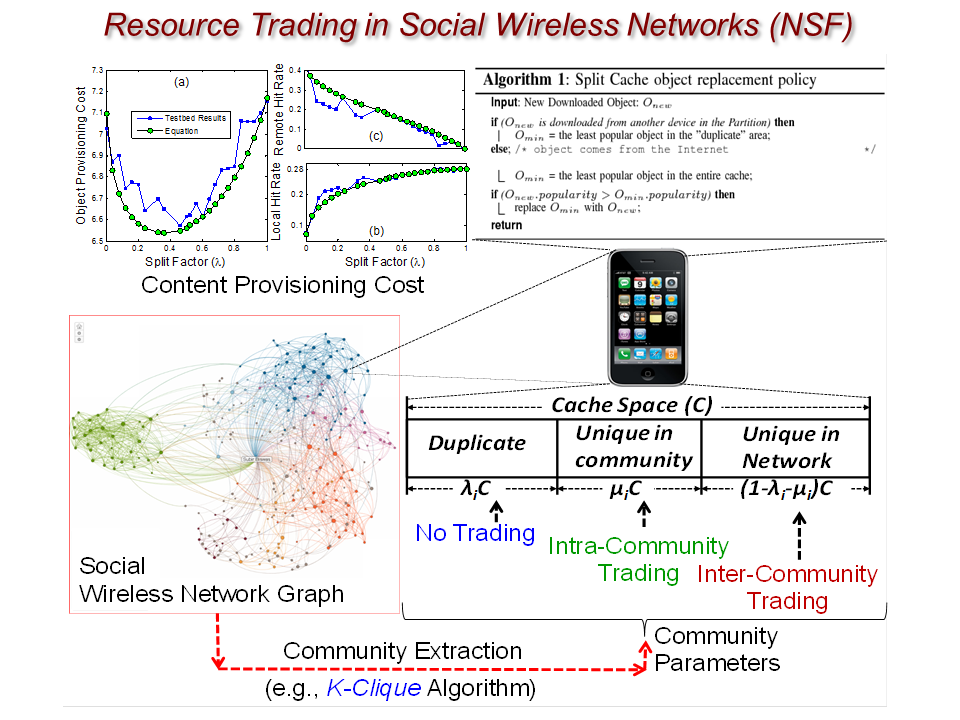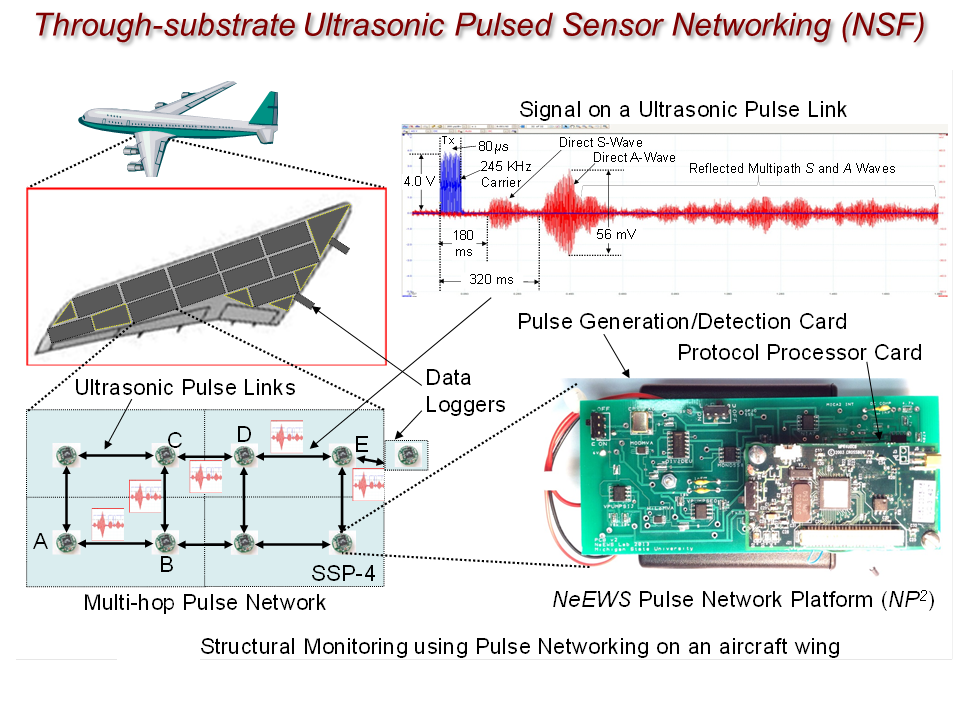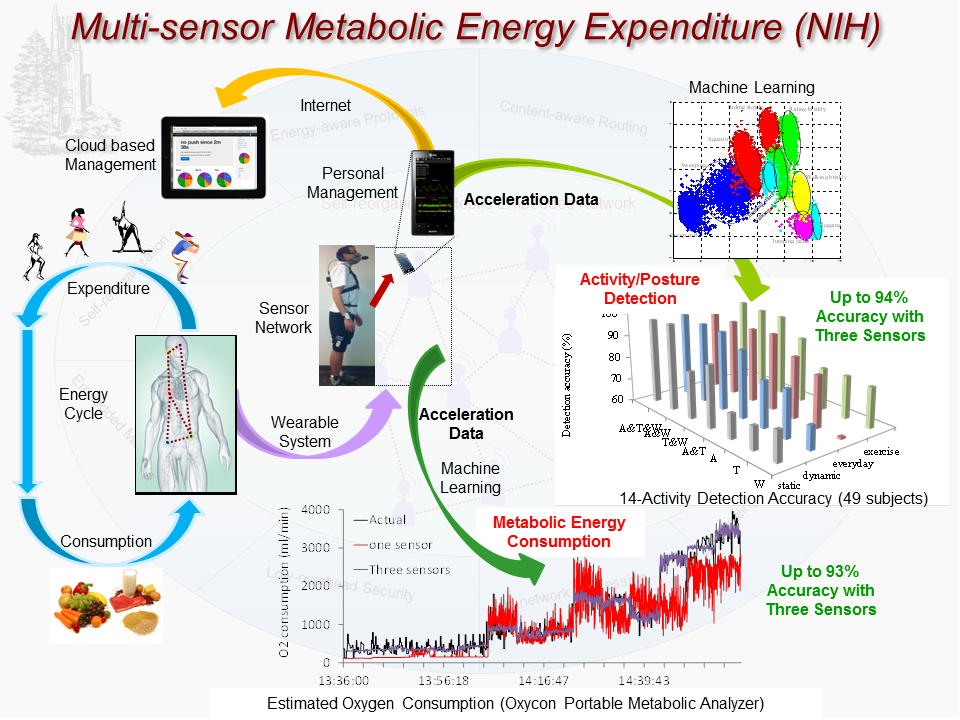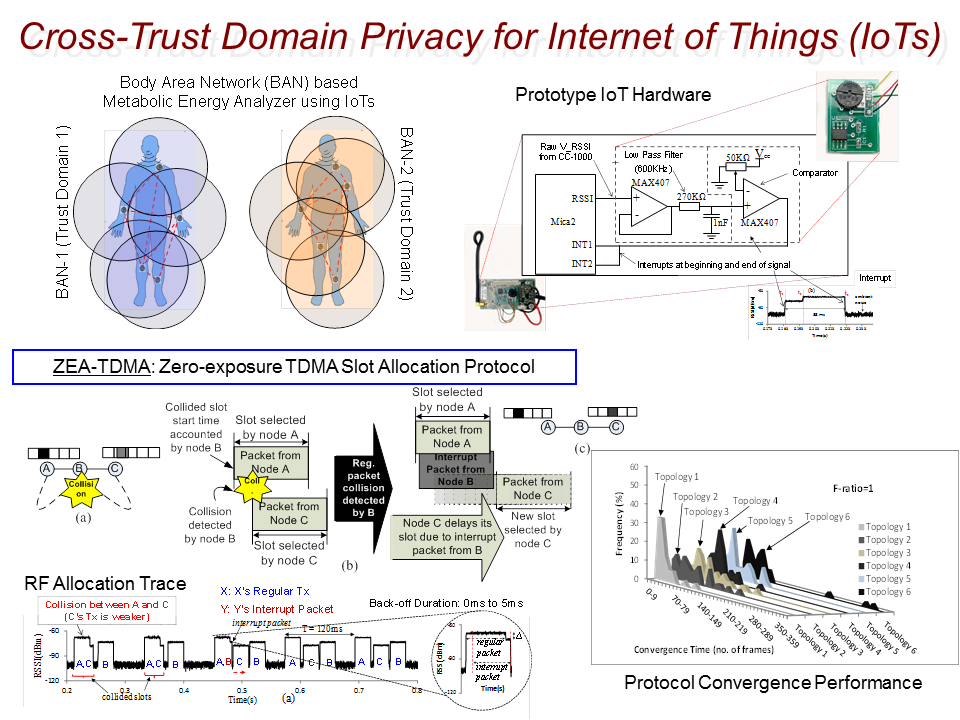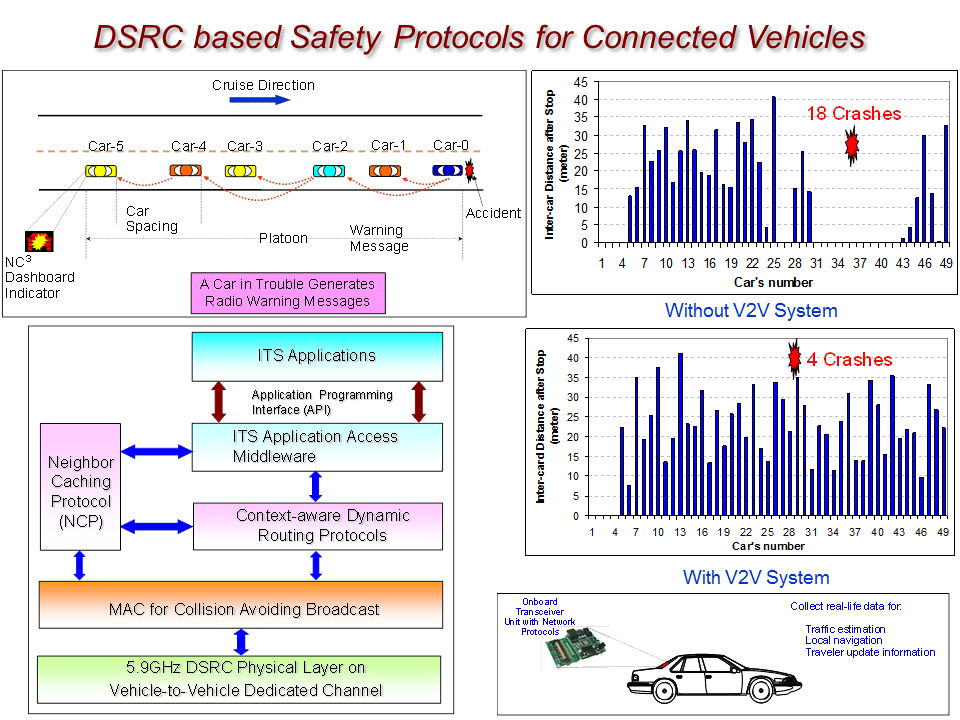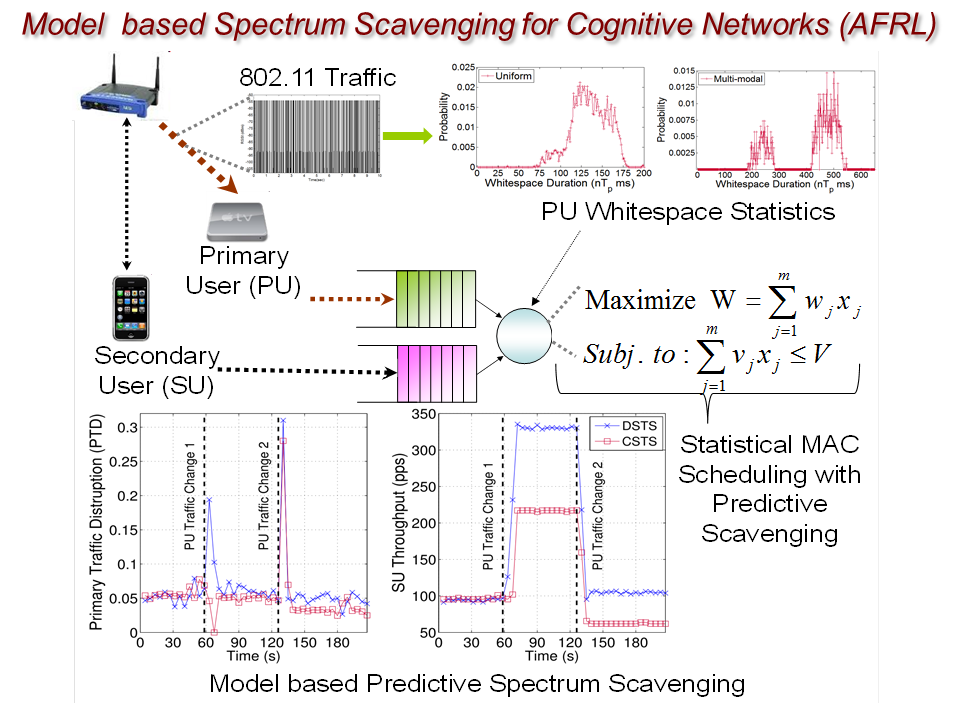|
Research Projects |
|
Research in NeEWS laboratory spans across a wide range of embedded wireless networking and system design issues including resource-constrained, self-reconfigurable and cooperative network protocols, network middleware, radio spectrum scavenging, new modes of information switching in communication networks, wearable sensing for health applications, and data storage and dissemination in social wireless networks. A few representative research projects in the NeEWS laboratory are summarized below. One page Project Synopsys:
Cooperative Caching in Social Wireless Networks with Heterogeneous Content Demand Energy-aware Pulse Networking for Low-power Wireless Sensor Networks Powered by Energy Harvesting Ultra-low Power IoT and Sensor Communication using Pulse-coded Protocol Data Units Gain-aware Content Dissemination in Social Wireless Networks Contactless Activity Monitoring for Pervasive and Ubiquitous Sensing Towards Traffic Analysis based Detection of Encrypted Traffic Active Projects:
Cooperative Resource Trading for Capacity and Energy Management in Social Wireless Ecosystems: Near-field communication among physically collocated mobile devices is becoming a popular means for content sharing and distribution in social wireless networks. Increasing market penetration of mobile devices and their support for short-range radio links are making such networks a distinct possibility in settings such as a University and other public places. A social wireless network captures “physical” community formation which is complementary to the “virtual” grouping in traditional social networks such as Facebook. Computing, storage, and communication resources in such networks can often be scattered and fragmented, leading to inefficient utilization. This project explores an emerging architecture that can foster economic model based resource trading in such networks for addressing the utilization issues. Network operations based on various cost and pricing models are introduced to demonstrate how by leveraging the underlying social community abstractions, fragmented storage, computing, and communication resources can be better utilized. The following figure depicts a fragmented storage trading scenario developed for reducing content provisioning costs in a Social Wireless Network.
The research involves: 1) stochastic formulation of cost-reward flow among the network stakeholders, 2) developing optimal distributed cooperative trading algorithms, 3) characterizing the impacts of network, user and content dynamics, 4) investigating the impacts, and developing mechanism for controlling non-cooperation, and finally 5) investigating system performance using Android based prototype Social Wireless Networks. A paper on this work won the best paper award in IEEE COMSNETS ‘11, January 2011, Bangalore, India. Sponsor: National Science Foundation (NSF)
Pulse Switching for Packet-less Event Networking: This project investigates a novel pulse switching framework for ultra-light-weight network applications. The key idea is to abstract a single pulse, as opposed to multi-bit packets, as the information switching granularity. Pulse switching is shown to be sufficient for on-off style event monitoring applications (e.g., structural health monitoring) for which a monitored parameter can be modeled using a binary variable. NeEWS lab researchers have developed a joint MAC-routing architecture for pulse switching and multi-hop routing with a novel cellular localization strategy. The feasibility and performance of this system is currently being evaluated using Ultra Wide Band (UWB) and ultrasonic pulsed data links. The following figure shows a prototype system using ultrasonic pulse networking for structural health monitoring of an aircraft wing. The system uses aircraft wing substrate as the communication media for reporting fault information to data loggers through a multi-hop pulse network.
Key research contributions are: 1) ultrasonic and UWB pulse modulation, transmission, and detection algorithms, 2) MAC and routing layer protocols for packet-less access and forwarding of binary information, 3) cellular event localization, 4) pulse based transport protocols for handling loss, faults, and ambient substrate noise, 5) using on-substrate event pattern recognition using spiking neural networks for implementing cognitive substrates. A paper on this work won the best paper award in ICWMC 2012, June 2012, Venice, Italy.
Sponsor: National Science Foundation (NSF)
Collaborators: Dr. Shantanu Chakrabartty, Dr. Rigoberto Burgueno, Michigan State University
Networked Wearable Systems for Personalized Health Management: The objective is to develop sensing, networking, and data processing mechanisms for Connected and Personalized Healthcare infrastructure. The concepts are to sense multi-modal physiological data using low-power wearable sensors and to develop pattern identification abstractions for monitoring health dynamics for individuals. The following figure depicts a metabolic energy monitoring system developed by the NeEWS lab researchers. The system constitutes: 1) a wearable sensor for swallow detection for identifying food/drink intake, 2) a set of wearable accelerometers for identifying human activity detection, 3) a 900MHz wireless network for on-body data fusion, 4) a Bluetooth network for data collection by smart-phones, 5) machine learning algorithms for metabolic energy expenditure estimation and food/drink intake, and finally, 6) mobile Apps and a cloud based infrastructure for through-internet sharing and rendition to doctors, point-of-care providers, family/relatives, and the patient.
Key research contributions in this project are: 1) sensor hardware system for swallow detection, 2) low-power MAC and on-body DTN routing protocols, 3) zero-exposure TDMA protocols for privacy-preserving networking, 4) machine learning algorithms for metabolic energy consumption estimation, and 5) HMM-over-Matched Filter based mechanisms for solid/liquid swallow classification via apnea detection in breathing signals. This project is a part of the MSU TRIFECTA initiative between the colleges of Engineering, Nursing, and Comm. Arts. A paper on this work won the best paper award in ICICS, April ‘12, Irbid, Jordan.
Sponsor: National Aeronautics and Space Administration (NASA), National Institutes of Health (NIH), United States Department of Agriculture (USDA), Michigan Initiative for Innovation and Entrepreneurship (MIIE) Collaborators: Dr. Jongeun Choi, Dr. Steve Kozlowski, Dr. Karin Pfeiffer, Dr. Janice Siegford,
Privacy Preserving Channel Access for Internet of Things: In this project we develop a new way of providing privacy for Internet of Things (IoTs) in a heterogeneous environment. The key idea is to develop a privacy-aware slotted channel access mechanism using which IoTs from multiple operators or trust domains can share wireless channel without mutually exposing their identities, thus alleviating threats from cross-trust-domain traffic analysis geared towards node-profiling, link layer topology estimation, node-tracking, and flow-tracking.
The proposed scheme uses a novel zero-exposure slot allocation strategy in which packet transmission timing is the only information that is used for scheduling, collision detection, and collision resolution purposes. In addition to the proposed access scheme, the project deals with the design of a custom hardware unit for implementing the proposed protocol in a test-bed of sensors, emulating IoT networks. Obtained performance results include functional validation and performance of the proposed channel access while preventing complete cross-trust-domain identity exposure. Vehicular Communication Protocols for Enhancing Highway Traffic Safety: This project develops a vehicular networking framework for highway safety applications. The project involves the following two components. The objective of the first component is to evaluate the impacts of contention and schedule based medium access control protocols on safety and data oriented Intelligent Transportation System applications. While the schedule based vehicular TDMA protocols can offer bounded and smaller delay compared to the contention based MAC protocols such as IEEE 802.11, the slot reallocation delay of the TDMA protocols during network topology changes can incur a significant latency that is detrimental for the delay critical ITS safety applications.
We study these effects and various tradeoffs not only at the network level performance, but also at the ITS application layer performance such as the vehicle crash statistics. The second component deals with vehicular packet routing mechanisms for reducing broadcast traffic for enhancing inter-vehicular packet delivery performance. We have developed an ns2 based discrete event hybrid simulator InventSim, which is used for jointly simulating DSRC based vehicular wireless networks, highway vehicle traffic with car following logic and various drivers’ reaction models, and ITS application interface to the wireless network.
Sponsor: National Science Foundation (NSF) and Michigan Department of
Transportation (MDoT)
Collaborator: Dr. Francois Dion,
Capacity Scavenging via Whitespace Modeling in Wireless Networks: Dynamic Spectrum Access can enable secondary network users to access unused spectrum, or whitespace, which is found between the transmissions of primary users in a wireless network. The design objectives for secondary user access strategy are to be able to “scavenge” spatio-temporally fragmented whitespace while limiting the interference caused to the primary users. In this project, we develop secondary user access strategies that are based on measurement and modeling of the whitespace as perceived by the secondary network users. A secondary user continually monitors its surrounding whitespace, models it as a stochastic process, and then attempts to access the available spectrum holes based on those models. The following figure summarizes the bandwidth scavenging system components and their architectural relationships.
Key research contributions are: 1) developing models for characterizing primary user shite space and secondary user access strategies, 2) numerical evaluation of the secondary users’ throughput and primary users’ interference, 3) simulation for validating system effectiveness, and 4) developing a 900MHz prototype network for experimental validation and performance evaluation. A paper on this work won the best paper award in Globecom 2009, November 2009, Honolulu, Hawaii.
Sponsor: Airforce Research Laboratory (AFRL), National Science Foundation (NSF)
Collaborators: Dr. Vasu Chakravarty, Air Force Research Laboratory. Completed Project Details:
Controlled Mobility for Performance Enhancements in Wireless Sensor Networks: This project investigates the role of controlled node mobility for enhancing data collection and energy performance in wireless sensor networks. The goal is to develop joint mobility and packet routing protocols, and to study the associated tradeoffs from a network design standpoint. The project deals with networks with static sensors and mobile sinks which correspond to applications such as Unmanned Air/Ground Vehicles (UAV, UGV) based data collection from unattended static sensor units. A generalized analytical formulation for mobile sensor based data collection has been developed with varying levels of static sensor to mobile sink multi-hop routing, which is parameterized as a hop-bound factor k. The key concept is to appropriately adjust the extent of multi-hop routing and the corresponding sink trajectory by varying the hop bound factor k. The main result is that for given sensor data rates and node density, there are clear bounds to the extent of multi-hop routing that can be sustained in a network. In other words, to maintain data collection stability from delay and capacity standpoints, the extent of multi-hop routing (hop-bound factor k) needs to be within a feasible range – rendering data collection with static sink often infeasible. This result is experimentally validated by developing a Network-Assisted Data Collection (NADC), which is a distributed and location-unaware sink navigation and data routing protocol. The NADC framework is also extended for networks with spatially heterogeneous data generation rates, and the routing feasibility results are being validated for such scenarios.
Sponsor: Air Force Research Laboratory (AFRL)
Adaptive Protocol Switching with Traffic Heterogeneity in Wireless Networks: This project investigates an inter-MAC self organization framework in the form of dynamic protocol switching. The main objective is to make a network adaptable with dynamic loading conditions while providing acceptable user performance. The key concept is that a network node can autonomously switch across different MAC layer protocols as a response to network traffic heterogeneity. Each node monitors its neighborhood traffic information to decide the most appropriate MAC protocol under the present traffic situation. The project develops: 1) traffic load measurement and modeling techniques, 2) MAC protocol switching logic between a CSMA/CA and a TDMA protocol, and c) an experimental framework for evaluating the impacts of protocol switching in terms of throughput enhancements and transient packet losses. The developed switching mechanism in this project is currently being explored in an inter-disciplinary project involving poultry bird welfare monitoring via networked characterization of space and resource usage within a poultry setting.
Sponsor: United States Department of Agriculture (USDA)
Collaborators: Dr. Janice Siegford, Michigan State University
Hybrid Routing with Off-Network Control Processing for Very Large Sensor Networks: This project explores a novel architectural solution to address the problem of scalable routing in very large sensor and embedded networks. The control complexities of the existing sensor routing protocols, both flat and hierarchical, do not scale very well for large networks with potentially thousands of embedded devices. Our approach is to develop a routing solution Off-Network Control Processing (ONCP) that achieves control scalability in large sensor networks by shifting certain amount of routing functions to an “off-network” server. A tiered and hybrid routing approach, consisting of “coarse grain” server based global routing, and distributed “fine grain” local routing is leveraged for achieving scalability by avoiding network wide control message dissemination. In addition to analytical characterization and ns2 based simulation modeling, the ONCP architecture is currently being implemented in an in-laboratory sensor network for studying its proof-of-concept scalability compared to the existing sensor routing solutions TinyDiffusion and TinyAODV.
Sponsor: National Science Foundation
Self-reorganizing TDMA for Sensor Networks: The goal of this project was to develop an architectural model that would allow cluster based TDMA without using spectrum-heavy CDMA or FDMA in cost-constrained sensor networks. The main idea behind this architecture is to develop a Self Reorganizing Slot Allocation (SRSA) mechanism, and a hierarchical routing protocol that leverages SRSA in multi-cluster sensor networks. We have developed models and algorithms for adaptive MAC slot allocation that can minimize inter-cluster TDMA interference under low sensor traffic situations. Successful development of such distributed algorithms can allow low-cost sensor nodes to do away with CDMA and FDMA for avoiding inter-cluster interference. Being able to avoid these wideband mechanisms, while leveraging the inherent energy-advantages of TDMA, can have far reaching implications for energy-aware networking in a slew of sensor application.
In-band Self-organization in MAC Protocols for Sensor Networks: This project investigates a self-organizing MAC protocol framework for distributed sensor networks with arbitrary mesh topologies. The novelty of the proposed In-band Self-Organized MAC (ISOMAC) framework lies in its in-band control mechanism for exchanging TDMA slot information while distributed MAC scheduling. A fixed length bitmap vector is used in each packet header for exchanging relative slot timing information across immediate and up to 2-hop neighbors. It is expected that by avoiding explicit timing information exchange, ISOMAC should work without network-wide time synchronization which can be prohibitive for severely cost-constrained sensor nodes in very large networks. A slot-clustering effect, caused by in-band bitmap constraints, is expected to offer better spatial channel reuse compared to traditional distributed TDMA protocols. ISOMAC employs a partial node wake-up and header-only transmission strategy to adjust energy expenditure based on the instantaneous nodal data rate. ISOMAC framework had been evaluated through analytical and simulation models, and a prototype implementation using Crossbow’s MICA2 sensor nodes.
Sponsor: National Science Foundation
Resource Management in Cognitive Networks with Dynamic Spectrum Opportunities: The availability of multiple interfaces with software radio, and dynamic choice of communication channels in wireless devices are expected to alleviate the channel crowding and its subsequent capacity limitations that exist in traditional single channel wireless mesh networks. Although having multiple radio interfaces and available channels can generally increase the effective throughput, a problem arises as to what is the best strategy to dynamically assign available channels and other resources to multiple radio interfaces for maximizing effective network throughput by minimizing the interference. This project investigates a distributed and localized interference-aware channel and resource assignment framework for multi-radio wireless mesh networks in a cognitive network environment. The framework being investigated uses a novel interference estimation method by utilizing distributed conflict graphs at each network interface to model the interference. Design and evaluation of the framework is currently being carried out on an 802.11 based multi-radio mesh network environment.
Sponsor: Air Force Research Laboratory (AFRL)
Multi-target Tracking using Networked Unmanned Vehicles: We develop a collaborative target tracking framework, in which distributed mechanisms are developed for tracking multiple mobile targets using a team of networked unmanned vehicles. Applications of such a networked tracking framework would include detection of multi-agent intrusion, network-assisted attack localization, and other collaborative search scenarios. The key idea of the framework is to design distributed algorithms that can be executed by tracking entities using a mobile ad hoc network. In addition to simulation studies, the developed tracking algorithms in this project are implemented and validated using a fleet of Swarm Capable Autonomous Vehicle (SCAV) system that is developed in our laboratory.
Collaborators: Dr. Jongeun Choi, Michigan State University
Biologically Inspired Mobility Control for Energy Conservation in Sensor Networks: This project develops a mechanism for extending network life by introducing energy-aware mobility in wireless sensor networks. The concept of controlled mobility for energy saving has been motivated by a natural grouping behavior that is observed in Emperor penguins in the Antarctic region. During the winters, a group of emperor penguins form a closely huddled group to improve their collective heat insulation. Individual penguins within a group exhibit a local mobility pattern that ensures that each individual spends roughly equal amount of time at the periphery of the group, where heat loss is the maximum. As a result, the total heat loss of the group is thought to be evenly distributed across all the individuals. In this project, we first draw a parallel between the heat loss of a penguin at the group periphery, and the routing energy burden of sensor nodes near the aggregating base stations. Then we develop a fully distributed and localized mobility control framework for collective extension of the network life. The mobility control algorithms developed in this project are now being implemented using the Swarm Capable Autonomous Vehicle (SCAV) system developed in our laboratory.
Routing with Persistent Link Modeling in Intermittently Connected Wireless Networks: A link state routing protocol framework for intermittently connected wireless networks has been investigated in this project. The key idea behind the developed Routing with Persistent Link Modeling (RPLM) is to design a link cost metric which reflects the state of a link based on its historical connectivity characteristics. In other words, connectivity and disconnectivity of a link is made to appear persistent using a gradually changing link metric. Persistent link modeling has the advantage of capturing any spatial and temporal locality of link disconnection and leveraging it for better route selection in intermittently connected networks. The link metric in this project was designed specifically for minimizing data delivery latency. The project activities included design and ns2 based functional validation and performance evaluation of RPLM in terms of delivery time, network utilization and buffer usage.
Fair Capacity Distribution for Wireless Networks with Contention-based Medium Access: This project has developed a network-triggered feedback control framework for addressing the inherent hop-unfairness in random access wireless networks. It was experimentally shown that when multiple flows with varying hop-counts compete for wireless bandwidth, the shorter flows can consume an unfair share of the total bandwidth by diverting capacity from longer hop flows. Experimentally, it was also demonstrated that this effect is not mitigated by the end-to-end feedback mechanism used by rate adaptive transport protocols such as TCP. The goal of this project was to devise an alternative feedback mechanism that can alleviate this problem of unfair capacity distribution, by introducing a hop-count independent feedback propagation mechanism. This has been accomplished by a network-triggered framework that, unlike TCP, relies on network generated feedbacks for application data rate adaptations. The proposed framework was developed using the Ad Hoc On-Demand Distance Vector (AODV) routing protocol and was characterized using ns-2 network simulator.
Managed Traffic Evacuation using Distributed Sensor Processing: In this project we have developed an integrated sensor network and distributed event processing architecture for managed in-building traffic evacuation during natural and human-initiated disasters, including earthquakes, fire and biological/chemical terrorist attacks. The networking components of the system were constructed using distributed wireless sensors for measuring environmental parameters such as temperature, humidity, and detecting unusual events such as smoke, structural failures, and vibration. Distributed event processing algorithms are executed by these sensor nodes to detect the propagation pattern of the disaster and to measure the concentration and activity of human traffic in different parts of a building. Based on this information, dynamic evacuation decisions are taken for maximizing the evacuation speed and minimizing unwanted incidents such as human exposure to harmful agents and stampedes near exits. A set of audio-visual indicators and actuators are used for aiding the automated evacuation process. We have developed integrated protocols, algorithms and their simulation models for the proposed sensor networking and the distributed event processing framework. Results obtained through simulation are used for a detailed characterization of the proposed evacuation management system and its associated algorithmic components.
Distributed Sleep-Scheduling Protocols for Energy Conservation in Wireless Networks: This project had explored a distributed sleep scheduling mechanism that can be used for implementing synchronous interface sleep for energy conservation in wireless Ad Hoc networks. The central idea of this protocol is to distribute a common sleep-awake cycle schedule among all nodes within a connected partition so that the nodes can turn their interface off during the sleep section of the agreed upon schedule, and they can communicate during the wake section of the schedule. By turning the interface off, the nodes can avoid idle listening consumption, which is a known reason for non-essential energy drainage in random-access network interfaces such as those running IEEE 802.11. This protocol is suited for low to moderate network loading conditions. The proposed distributed protocol employs a novel schedule synchronization technique that can work without any local time synchronization and can deliver low convergence latencies. Another notable feature of the protocol is its ability to work with unmodified existing MAC layer protocols such as 802.11. We have developed an ns2 based simulation model of the proposed distributed scheduling and sleep protocols for evaluating and comparing their energy performance with those of plain 802.11 MAC and a centralized scheduling mechanism. MSU ECE Department College of Engineering Contact Us Biswas Home
© 2014 Subir Biswas, All rights reserved.
|


